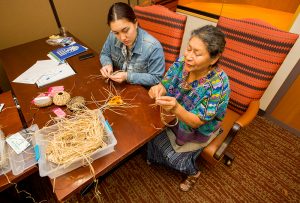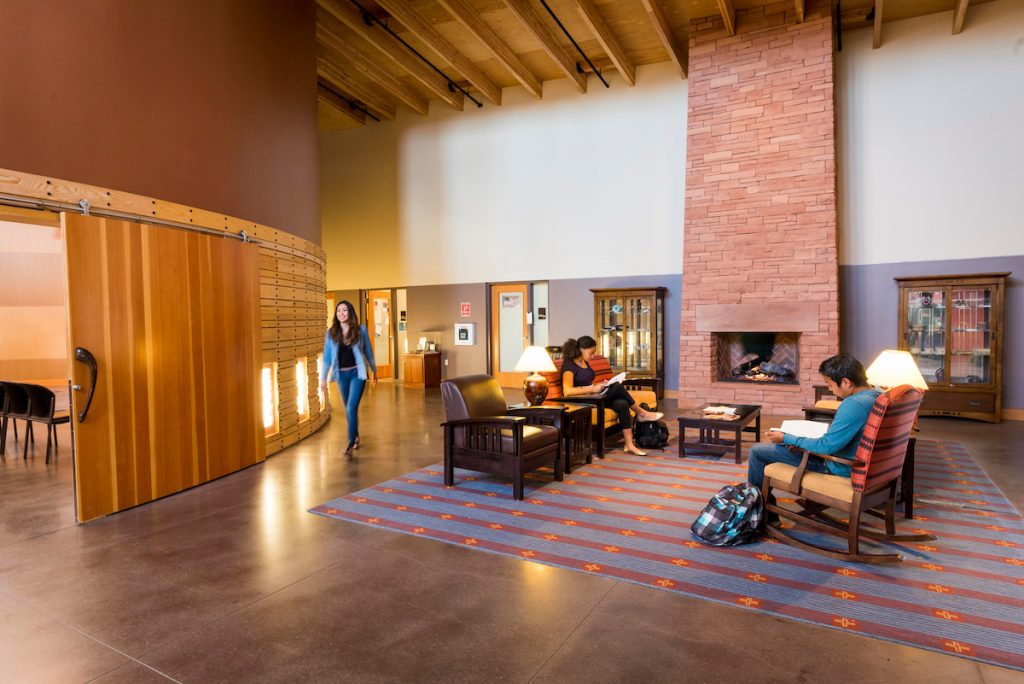By Heidi Toth
NAU Communications
Marina Vasquez can talk and weave a basket at the same time, never breaking stride with her needle as she shares stories of her Mayan culture and the ancient art of pine needle basketry.
“Three is the symbol of women in the Mayan culture,” she says as she wraps raffia three times around three pine needles. “And nine is the symbol of life.”
Her basket quickly takes shape; everyone else in the room struggles to hold the wet pine needles in place as they attempt to sew. For Vasquez, a Mayan Indian and an elder at the Native American Cultural Center (NACC) at Northern Arizona University, both the talking and the weaving come naturally. They are two of her greatest tools in sharing her heritage and helping others connect with their own.
Vasquez and Lorenzo Max, a Diné Indian, are part of the Elder Cultural Advisors program, which brings Native American educators to NAU to provide guidance and support to students from Native American tribes. They also provide educational and cultural learning opportunities to any interested students, faculty and staff. During November, they are even more visible as the NACC and various groups host a number of events to celebrate Native American Heritage Month.
The NACC is open to all students at NAU, and executive director Ora Marek-Martinez said more than 50,000 people have come through its doors in the last 18 months or so for educational opportunities, to get support or find a quiet place to study or rest between classes. But at its core, the center and its program aim to replicate the environment Native American students experience in their communities to help them succeed when they come to college.
“For us, this is just a way we can create that home away from home mentality,” Marek-Martinez said. “We are your family while you’re here, we’re here to support you and we recognize the roles that we play in our own communities.”
That commitment is exemplified through the elders.

Improving education
Elders play a unique role in Native American culture—passing down knowledge and wisdom of ancestors, the land, the stories and the arts of their people.
Max points to the educational process that takes place in labs, classrooms and the library. It’s good, he said, and he encourages all students to take advantage of these opportunities to learn. But such education isn’t complete, especially for native students. That knowledge isn’t found in textbooks or Lexus-Nexus searches.
“A lot of our knowledge is handed down from our ancestors through songs and prayers,” he said. “Since our ancestors didn’t always have a written language, there was still a need to preserve and record our history and important events. They preserved those in songs and prayers and ceremonies.
“That’s why it was important to hand down those songs and prayers, because one song could be like a book or it could be like a chapter in a book. Each song, each prayer tells a story of some significant event.”
The Elders Cultural Advisor program intends to replicate the role of elders for students, offering a way to gain access to the lessons, support and perspective they could access in their communities. The program has been part of NAU for almost 20 years, but only recently has it been under the purview of the NACC. Before that it was part of the Applied Indigenous Studies (AIS) program, in which both Max and Vasquez are faculty members. They serve as educators but also have a distinct role as advisers, Marek-Martinez said.
Max and Vasquez teach classes. Vasquez’s expertise is in traditional medicinal plants, and this semester she’s teaching AIS 299, which covers the politics, culture, history and art of the Mayan people. In the last five weeks of the class she switches to ethnobotany, teaching students how to make face cream, lip balm, salve and other products from medicinal plants.
Max’s focus is on Navajo culture. He works with a Navajo language instructor to provide a conversational, natural Navajo environment for students. Native Americans of his generation went to government schools and were told not to speak their tribal languages, so the generation after his never learned their native tongue even though many have grandparents or relatives who only speak that language.
“The government school told us just being an Indian was no good—reinforcing in our mind that we were inferior, that we were never going to be as good as mainstream society,” he said. “That had a really tremendous effect on us not passing who we are onto our kids. That was wrong. A lot of the values of who we are, our self-identity, was eroded away.”
These classes, lectures and demonstrations the elders give now help to restore the identity of Native Americans and the value of each tribe’s individual culture. Max talks about Native Americans’ relationship to the land and nature and their different ways of learning and worshiping. Vasquez, while teaching about her Mayan culture and artistry, encourages students to embrace their own inner artist and to use these ancient practices to find peace in stressful times.
Offering love and support

In addition to their teaching role, elders serve as advisers to students and occasionally faculty and staff. This is especially important, Marek-Martinez
said, because many Native American students are the first in their families to seek college degrees. Many come from small, rural communities, so college is a culture shock. They also grew up in close-knit, supportive environments in which everyone learned from everyone else. All of this can make the transition to college life, and success in college, difficult.
But it doesn’t have to be that way. Think of the NACC as your home away from home, Marek-Martinez tells students. Come for help, support, to take a break during the day, to grab a cup of coffee before an early class. And come for the support of elders, who hold a significant role in Native American communities.
“When our students go to our elders, they play very similar roles as they do in our community, where they provide guidance that we need, help us overcome problems in our own ways,” Marek-Martinez said. “But then they also are reminding us of our culture and our language and really providing that resiliency piece: Keep going. Move forward. This is going to be a good thing for you and your community, for your family, for your people.
“They are a really good source of encouragement for our students.”
What students seek out the elders for can range from depression to being stressed o
ver a test or project to trouble with professors to fights with girlfriends, boyfriends or roommates. Vasquez has a routine for each one. If a student is depressed, she takes them to the health center. If a student feels unfairly treated by a professor, she first asks if they’ve done all of their assignments. If the answer is no, she sends them away until they complete their work, but if it’s yes, she’ll call the professor and advocate for the student’s aside. Relationship troubles she gives advice and talks them through difficult languages.
Students who are stressed, she pulls out pine needles and raffia and tells them to start weaving. The number of pine needle baskets made goes up significantly come finals time.
“Pretty much my role here is to empower students who feel neglected, empower those who need help, who are away from home and don’t have families here,” she said. “You have to know exactly where you come from, who you are and what is it you preach because whatever you preach, it’s going to have a result.
“To me this is the greatest thing I can do. I feel like the Great Spirit put me here for a reason.”
Max also sees the benefit of the support he and Vasquez provide. As an NAU student who was here in the 1980s, he felt the deficit of not having someone like the elders to help him through difficult times. While he was here, he’d gather with other Native American students to fill that gap, meeting on the hill south of where the Southwest Forest Science Complex now sits—a hill that at the time was empty but how houses a Hogan.
“A lot of us young native students, we used to gather there to sing and hit the drum,” Max said. “We didn’t have any money to go home on weekends, so a lot of us just hung out there for support. Sometimes we talked to each other or used that area to make a prayer offering, knowing that one day there would be a Hogan there.”
He sees his primary goal simply: to get students to maximize their hózhǫ́, just as their ancestors did. Hózhǫ́ means happiness and joy, and maximizing that in students’ lives will help them make positive choices, focus on the beauty surrounding them, be more compassionate and be open to giving and receiving love unconditionally.
“It’s a universal concept,” he said. “My doors are open; I am here on campus to help the students, and a lot of times I find myself helping faculty members and staff members. My doors are open to anybody. I’m here to try to make a difference so people can have more happiness and joy.”




